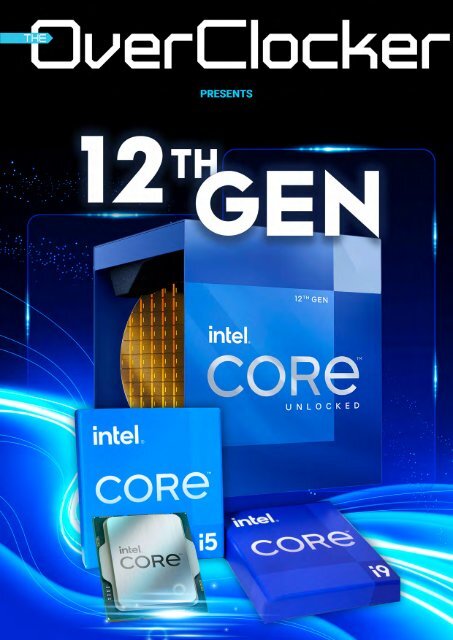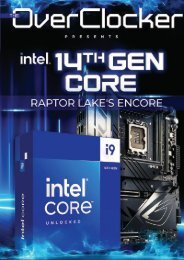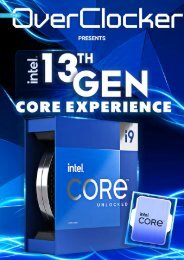TheOverclocker Presents Intel 12th Gen core
Retrospective magazine on 2021's revolutionary Intel 12th Gen Core CPUs. The first desktop hybrid CPU for consumers.
Retrospective magazine on 2021's revolutionary Intel 12th Gen Core CPUs. The first desktop hybrid CPU for consumers.
You also want an ePaper? Increase the reach of your titles
YUMPU automatically turns print PDFs into web optimized ePapers that Google loves.
THE OVERCLOCKER | PRESENTS<br />
A RETROSPECTIVE PERSPECTIVE<br />
It’s been eight months since INTEL unveiled the <strong>12th</strong> <strong>Gen</strong> Core series of CPUs.<br />
This generation has brought hybrid CPUs, PCI Express <strong>Gen</strong> 5 and DDR5 memory<br />
to the desktop. While it’s possible to use a <strong>12th</strong> <strong>Gen</strong> CPU without these supporting<br />
technologies. More on DDR5 later, but for now, at least for the best performance, high<br />
speed DDR5 is essential. This was obvious at launch, but more so today.<br />
THE OVERCLOCKER PRESENTS <strong>12th</strong> GEN CORE<br />
Before we speak about<br />
performance, it’s<br />
important to highlight the<br />
hybrid nature of <strong>12th</strong> <strong>Gen</strong> CPUs<br />
for obvious reasons. It’s a first<br />
for desktop and looks to be the<br />
future for INTEL, at least in<br />
some SKUs. At present, only<br />
Core i5, i7 and i9 are hybrid<br />
CPUs for they contain within<br />
them E or efficient <strong>core</strong>s.<br />
According to INTEL, efficient<br />
<strong>core</strong>s increase computing<br />
efficiency and deliverintelligent<br />
workload optimization. This<br />
statement, when translated<br />
to normal speak, means the<br />
E-<strong>core</strong>s where appropriate,<br />
take over tasks such as web<br />
browsing and video stream<br />
encoding. When called upon,<br />
these <strong>core</strong>s can also help<br />
the P-<strong>core</strong>s in highly threaded<br />
tasks. Performance withstanding,<br />
E-<strong>core</strong>s improve power efficiency<br />
and, as a result, lower overall<br />
power consumption for common<br />
task.<br />
E-<strong>core</strong>s aside, the real action<br />
is with performance or P-<strong>core</strong>s.<br />
These Golden Cove <strong>core</strong>s, in<br />
terms of raw performance,<br />
are the beating heart of <strong>12th</strong><br />
<strong>Gen</strong> CPUs and unlike E-<strong>core</strong>s,<br />
P-<strong>core</strong>s are available on all<br />
SKUs and what most of the<br />
excitement is about. INTEL<br />
delivered on the promise of<br />
vastly improved IPC, clock<br />
frequencies, and power<br />
consumption. Prior to launch,<br />
there were rumours of factory<br />
frequencies well above 5GHz,<br />
with some predictions as high<br />
as 5.4GHz. This turned out to be<br />
true and false simultaneously.<br />
The range topping <strong>Intel</strong> Core i9<br />
12900KS does indeed feature a<br />
5.5GHz maximum turbo<br />
frequency, but this SKU wasn’t<br />
around at launch. What was<br />
available, the Core i9 12900K,<br />
could only claim 5.2GHz as its<br />
maximum clock frequency.<br />
Overclockers and enthusiasts,<br />
however, often manage much<br />
higher frequencies, anywhere<br />
between 5.4 to 5.6GHz depending<br />
on the quality of the silicon.<br />
Against the previous 11th<br />
<strong>Gen</strong>eration Core CPUs, the <strong>12th</strong><br />
<strong>Gen</strong> CPUs achieve an uncontested<br />
victory in every test, game, and<br />
application imaginable. E-<strong>core</strong>s<br />
aside, the equivalent <strong>12th</strong> <strong>Gen</strong><br />
CPU is vastly superior not only<br />
in performance but in total power<br />
consumption. Unfortunately,<br />
for INTEL, the competition isn’t<br />
from 11th <strong>Gen</strong> Core CPUs, but<br />
AMD.<br />
<strong>12th</strong> <strong>Gen</strong> CPUs need to match
THE OVERCLOCKER PRESENTS <strong>12th</strong> GEN CORE<br />
AMD’s offerings in power,<br />
performance and price. While<br />
INTEL has, over the years, kept<br />
the single thread performance<br />
crown through frequency<br />
advantage, it’s not enough. In<br />
multi-threading performance,<br />
power and price AMD were<br />
superior.<br />
<strong>12th</strong> <strong>Gen</strong>eration CPUs have<br />
changed this at least in two<br />
parts, which is price and<br />
performance. The range topping<br />
<strong>Intel</strong> Core i9 12900K against its<br />
most obvious 12 <strong>core</strong> counterpart<br />
offers greater value and superior<br />
performance. Where power is<br />
concerned, INTEL has made<br />
great strides, but the competition<br />
still has the edge. Will the power<br />
advantage persist against 13th<br />
<strong>Gen</strong> Core? We will find out in a<br />
in a few months, but it’s worth<br />
nothing that 13th <strong>Gen</strong> Core<br />
CPUs use the same <strong>Intel</strong> 7<br />
process on <strong>12th</strong> <strong>Gen</strong> CPUs. The<br />
subject of power consumption<br />
is highly technical and it would<br />
be ridiculous to reduce it to a<br />
single value referring to absolute<br />
gate length.<br />
The move to a smaller<br />
manufacturing process is a<br />
big step for INTEL, finally free<br />
from criticism for repeated use<br />
of their 14nm process. INTEL<br />
has taken further advantage of<br />
the situation, introducing a new<br />
naming scheme and process<br />
road map. Gone is the reference<br />
to the actual gate length and,<br />
in its place, marketing friendly<br />
terminology. What they refer to<br />
as 10nm is today called INTEL<br />
7, and its replacement 7nm<br />
process; INTEL 4 (7nm). We<br />
can find here more information<br />
on future process names.<br />
All this aside, and almost a<br />
year after launch, I consider<br />
the <strong>12th</strong> <strong>Gen</strong> Core CPUs a success.<br />
INTEL’s Core i3 and i7 offer<br />
phenomenal value against<br />
competition’s offerings and<br />
perhaps against the i9 itself.<br />
In instances such as gaming,<br />
the Core i7 12700K delivers<br />
comparable performance to<br />
the 12900K. Since both SKUs<br />
feature unlocked frequency and<br />
DRAM ratios, many users have<br />
matched and even exceeded<br />
12900K performance. For most<br />
users, the absence of four<br />
E-<strong>core</strong>s on the i7 makes little<br />
difference.<br />
Further down the hierarchy,<br />
we have the Core i5, with six<br />
P-Cores and four E-<strong>core</strong>s. With
...<strong>12th</strong> <strong>Gen</strong> CPU is vastly superior<br />
not only in performance but in total<br />
power consumption....<br />
THE OVERCLOCKER PRESENTS <strong>12th</strong> GEN CORE<br />
previous generations, this SKU<br />
offered the best value for money,<br />
but that may have changed.<br />
INTEL’s Core i3 12100, receives<br />
this honour instead. With just<br />
four P-<strong>core</strong>s, it outpaces the<br />
higher priced, previous generation<br />
Core i5 11400 in several common<br />
tasks, including gaming. At the<br />
time of writing, this CPU retails<br />
for $129. Incredible value,<br />
given that it outperforms 2020s<br />
10600K as well, despite the<br />
frequency and <strong>core</strong> disadvantage.<br />
The value provided over 11th<br />
<strong>Gen</strong> offerings is significant and<br />
one hopes this continues with<br />
13th <strong>Gen</strong> CPUs.<br />
CPU specifics aside, what<br />
compliments and completes<br />
this experience is the platform<br />
in its entirety. INTEL 600 series<br />
chipset brings several upgrades<br />
that make the upgrade worthwhile.<br />
As mentioned earlier,<br />
PCIe <strong>Gen</strong> 5 and DDR5 DRAM<br />
support are the highlights, but<br />
there’s more. The DMI 4.0 link<br />
between the CPU and Chipset<br />
offers four times the bandwidth<br />
versus DMI 3.0. Z690 specifically<br />
offers eight lanes instead of<br />
four, and each lane supports<br />
double the bandwidth. This<br />
arrangement allows exotic<br />
configurations of all sorts, with<br />
many high-end boards offering<br />
five M.2 sockets that mix<br />
<strong>Gen</strong>5, 4 and <strong>Gen</strong>3 compliance.<br />
INTEL 600 chipset improves<br />
connectivity over the 500 series<br />
with INTEL Wi-Fi 6E/7 AX211<br />
and more high-speed USB<br />
connections. These additions<br />
and enhancements mean the<br />
600 series offers the most<br />
feature rich platform right now.<br />
On to the fun part, overclocking.<br />
Things are more complicated<br />
with the <strong>12th</strong> <strong>Gen</strong> CPUs and it’s<br />
especially true for the Core i9<br />
12900K. The presence of E-<br />
<strong>core</strong>s and the ability to disable<br />
HT per <strong>core</strong> offers interesting
THE OVERCLOCKER PRESENTS <strong>12th</strong> GEN CORE<br />
configurations. For instance,<br />
I have found that disabling hyper<br />
threading reduces temperatures,<br />
while having a negligible effect<br />
on most applications I use. On<br />
previous generations, doing<br />
this would lead to significant<br />
performance losses. Fortunately,<br />
we have E-<strong>core</strong>s to compensate<br />
with as the small <strong>core</strong>s make<br />
up for the logical <strong>core</strong> reduction.<br />
Disabling hyper threading<br />
raises thermal headroom and<br />
allows higher clock frequencies.<br />
The CPU I used for testing<br />
reached 5.5GHz on a single<br />
<strong>core</strong>, 5.1GHz for all <strong>core</strong> loads<br />
and 4GHz for E-<strong>core</strong>s. For all<br />
this additional performance,<br />
the CPU saw a maximum and<br />
median power draw reduction<br />
of 20 percent. Sustained peak<br />
power draw (In stressful<br />
applications, not torture tests)<br />
was often below 190W.<br />
I have barely touched the<br />
surface of CPU<br />
overclocking and<br />
there’s plenty more,<br />
but for a thorough<br />
guide on tuning and<br />
overclocking <strong>12th</strong><br />
<strong>Gen</strong> Core CPUs,<br />
please check out<br />
SkatterBencher on YouTube.<br />
For extreme overclockers,<br />
<strong>12th</strong> <strong>Gen</strong> CPUs presents<br />
interesting options presented<br />
in unusual ways. All related to<br />
hardware categories on<br />
HWBOT. Be it you opt for the<br />
Core i7 or the i9 K SKU,<br />
8 Core (8P) category is where<br />
you’re competing. That should<br />
mean one can buy a Core i7<br />
12700K and compete with the i9<br />
CPUs, right? Sadly, the<br />
answer is no, as it appears<br />
Core i7 CPUs rarely achieve<br />
the same frequencies in<br />
extreme conditions. For the<br />
everyday overclocker using an<br />
AIO, this shouldn’t be an issue<br />
as differences between the i9<br />
and i7 will be minimal.
THE OVERCLOCKER PRESENTS <strong>12th</strong> GEN CORE<br />
Conclusion<br />
In closing, let’s return to 2020<br />
and remember that 11th <strong>Gen</strong><br />
Core CPUs put up a valiant<br />
fight, securing wins where its<br />
clock frequency advantage<br />
could assist. Unfortunately,<br />
these instances were far and<br />
few between, so we saw no<br />
price drops. <strong>12th</strong> <strong>Gen</strong>, however,<br />
changed the lay of the land,<br />
forcing AMD price drops.<br />
Acknowledging the value<br />
offered by <strong>12th</strong> <strong>Gen</strong> Core CPUs.<br />
In a few months, 13th <strong>Gen</strong><br />
Core squares off against AMD’s<br />
7000 series. From rumours and<br />
leaked performance figures,<br />
INTEL could claim victory,<br />
at least in multi-thread loads.<br />
Important as it’s been ages<br />
since AMD and INTEL engaged<br />
in a straight fight for performance<br />
dominance. We must thank<br />
competition for this.<br />
Last, I will discuss platform<br />
longevity for INTEL’s 600 series<br />
motherboards, a contentious<br />
issue for many end users and<br />
for valid reason. Users have<br />
invested into platforms only<br />
to discover a socket change<br />
just 12 months later. With 600<br />
series boards and matching<br />
LGA 1700 socket, things have<br />
changed. Current 600 series<br />
motherboards can accommodate<br />
13th <strong>Gen</strong> CPUs. Naturally, the<br />
best experience comes from<br />
the upcoming 700 series, but<br />
backward compatibility certainly<br />
brings relief to many. Some<br />
600 series motherboards<br />
carry a $700+ retail price and it<br />
would be a shame if upcoming<br />
CPUs relegated these to EOL<br />
status.<br />
For the budget conscious,<br />
there’s no better time to buy<br />
a <strong>12th</strong> <strong>Gen</strong> CPUs than today.<br />
The price of entry is cheaper<br />
for both motherboards and<br />
DDR5. This is unlike last year<br />
when DDR5 was slower, scarce<br />
and expensive, forcing DDR4<br />
alternatives on many users. As<br />
we’ve seen, the performance<br />
gained from high speed DDR5<br />
is staggering, at least where<br />
competitive overclocking and<br />
benchmarks are concerned. In<br />
gaming tests, we’ve also seen<br />
DDR5 come out ahead with<br />
DDR5 6000 or higher. 12900KS<br />
aside, the rest of the <strong>12th</strong> <strong>Gen</strong><br />
line-up offers good value, even<br />
today with 13th <strong>Gen</strong> Core CPUs<br />
imminent. Eight months ago,<br />
pure performance was the<br />
selling point, INTEL winning<br />
the performance crown<br />
convincingly over its<br />
competition. Today, it’s not just<br />
pure performance that’s notable,<br />
but the entire platform and<br />
supporting technologies that’ve<br />
matured, making the best<br />
possible case for <strong>12th</strong> <strong>Gen</strong><br />
Core CPUs.






